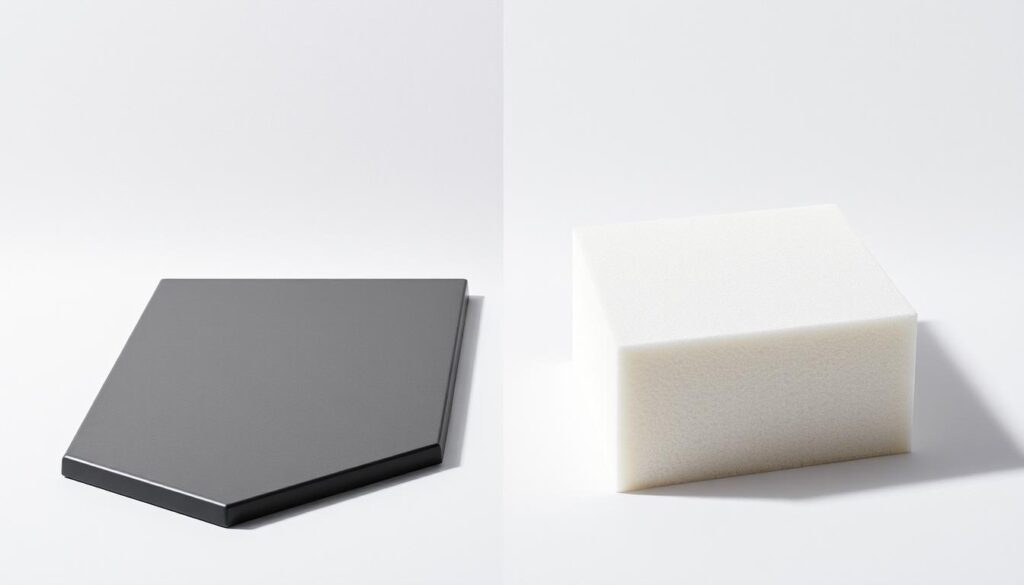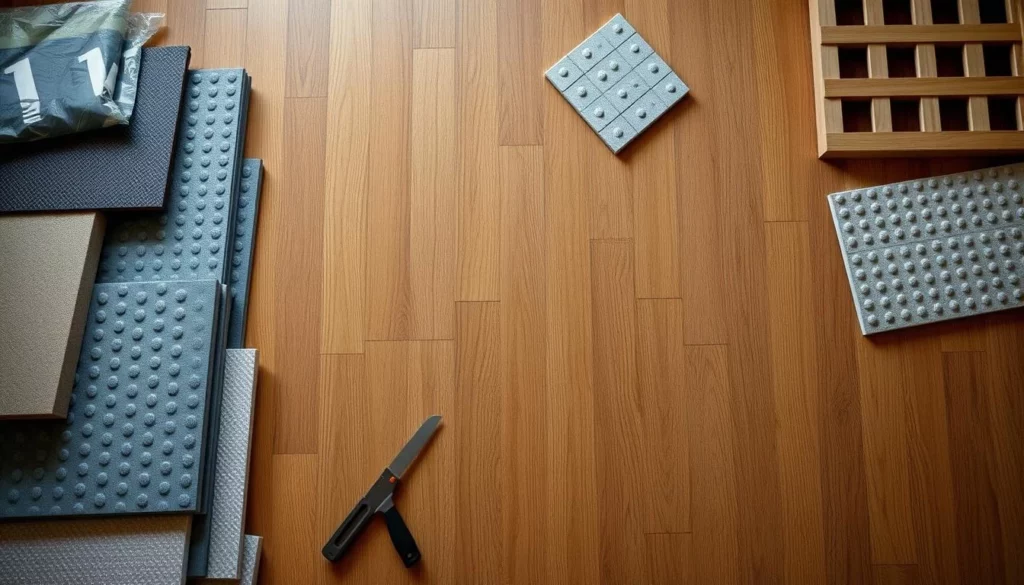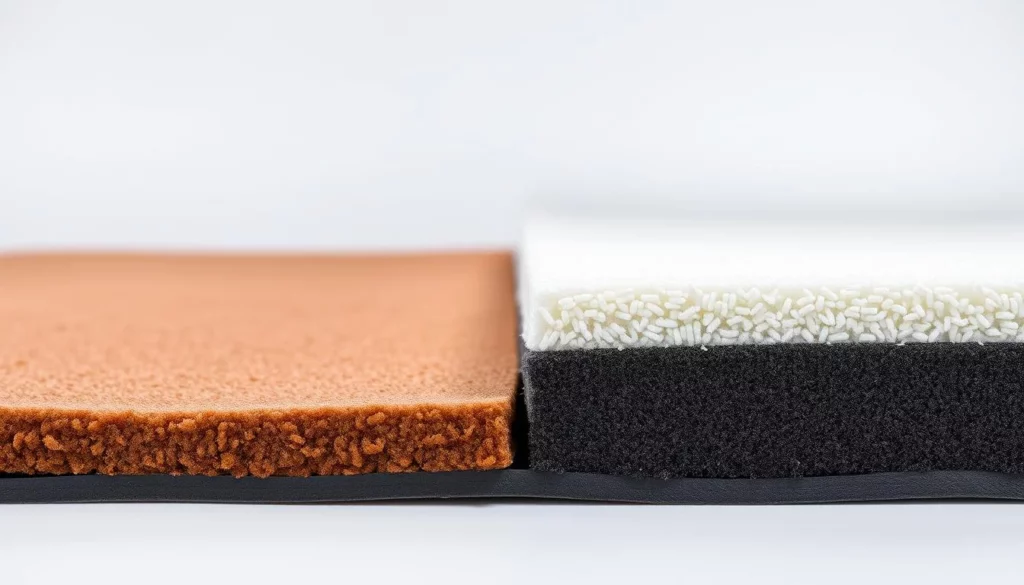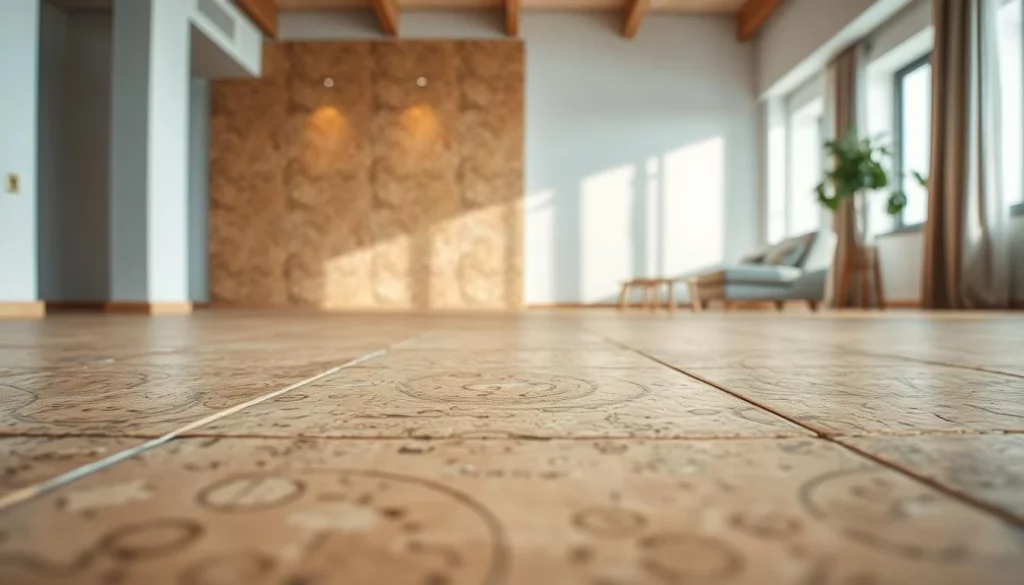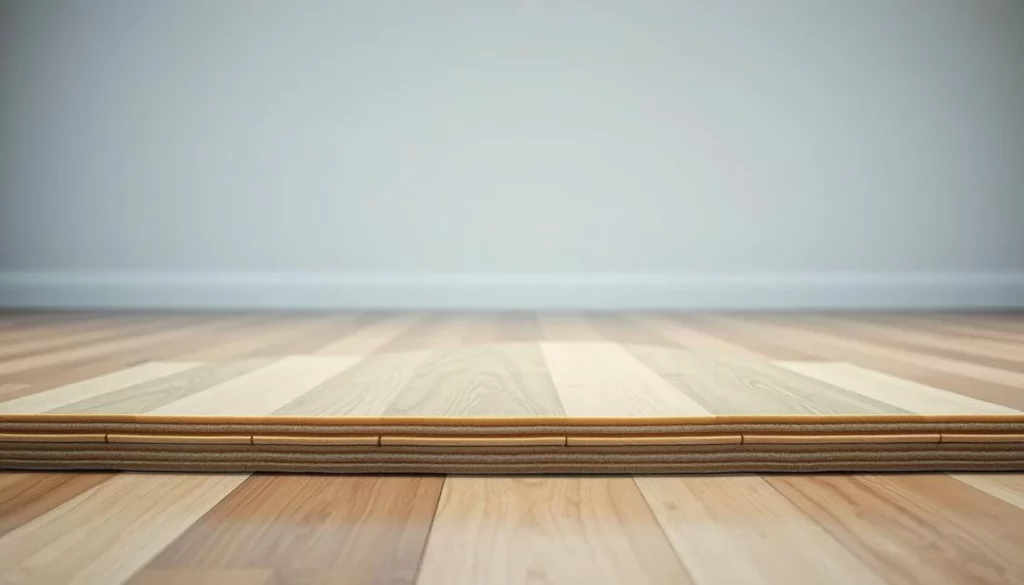Choosing the right underlayment for your home can be tough. You have to decide between rubber and foam underlays. Each has its own good points and not-so-good points. It’s important to think about these before you decide.
Durability and sound absorption are key when picking an underlayment. One material does well in these areas. The other is easier to install and costs less.
Think about damping noise and making your living space comfortable. By looking at what each material offers, you can choose what’s best for you.
Introduction to Underlays: Why They Matter
The underlay is key to any flooring system. It offers support and cushioning. It sits between the floor and the flooring material, ensuring your floors last long and perform well.
Underlays do more than just add a layer. They help reduce noise, make floors more comfortable, and keep moisture away from your flooring. With many options available, picking the right one is important for your needs.
Definition of Underlays
Flooring underlays are materials placed between the subfloor and the flooring surface. They help create a smooth surface, reduce noise, and keep floors warm. Rubber underlayment is a top choice because it’s durable and great at reducing noise.
Importance of Choosing the Right Material
Picking the right underlay is key for your flooring’s success. Different materials offer different levels of cushioning, noise reduction, and moisture protection. For example, rubber underlays are known for their noise reduction and durability. Foam underlays are often chosen for their affordability and easy installation.
| Underlay Material | Noise Reduction | Cushioning | Moisture Protection |
|---|---|---|---|
| Rubber Underlay | Excellent | Good | Excellent |
| Foam Underlay | Good | Excellent | Fair |
The underlay material you choose greatly affects your flooring’s performance and comfort. It’s important to think about your specific needs and preferences when deciding between rubber and foam underlays.
Overview of Rubber Underlays
Thinking about rubber underlays for your home? It’s key to know their main traits and perks. Made from recycled rubber, they’re eco-friendly. They’re also durable and great at absorbing sound, making your home more comfy and quiet.
Key Characteristics of Rubber
Rubber underlays have some standout features. They’re resistant to moisture, which cuts down mold and mildew risks. This makes your home air healthier. Plus, they’re very durable and can handle lots of foot traffic.
| Characteristics | Description | Benefits |
|---|---|---|
| Moisture Resistance | Rubber underlays are resistant to moisture, reducing the risk of mold and mildew. | Creates a healthier indoor environment. |
| Durability | Rubber underlays are durable and can withstand heavy foot traffic. | Long-lasting, reducing the need for frequent replacements. |
| Sound Absorption | Rubber underlays have excellent sound absorption properties. | Reduces noise, creating a more peaceful living environment. |
Benefits of Using Rubber Underlays
Using rubber underlays brings many benefits. They’re not just good at sound absorption and durability. They also make your home more comfortable and quiet. So, rubber underlays help you create a peaceful and healthy home.
Overview of Foam Underlays
Homeowners often choose foam underlays for their floors. They are known for being comfortable, durable, and easy to install. This makes them a great option for many flooring needs.
Key Characteristics of Foam
Foam underlays are lightweight and flexible. This makes them easy to handle and set up. They come in different thicknesses and densities. This lets homeowners pick the best one for their floors.
Benefits of Using Foam Underlays
Foam underlays offer great cushioning and help reduce noise. They also keep floors warm. Plus, they’re easy to cut and fit around tricky spots. This makes them perfect for DIY projects.
| Characteristics | Benefits |
|---|---|
| Lightweight | Easy to handle and install |
| Flexible | Can be cut to fit complex areas |
| Varied Thickness and Density | Suits different flooring needs |
Types of Foam Underlays Available
There are several types of foam underlays, like high-density foam, re-bond foam, and memory foam. Each type has its own benefits. They meet different flooring needs and personal tastes.
When picking a foam underlay, think about your flooring type, comfort level, and home needs. This will help you choose the right one.
Sound Absorption: Rubber vs. Foam
Both rubber and foam underlays help with sound absorption. But, they work better in different types of noise. It’s key to know how they perform in various settings.
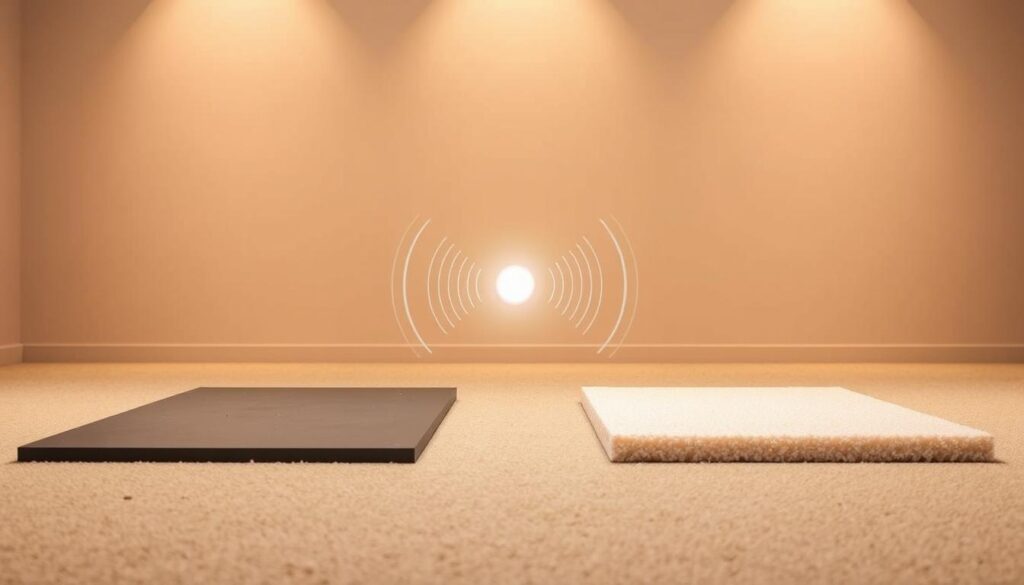
Noise Reduction Mechanisms
Rubber underlays are great at reducing impact noise, like footsteps and dropped objects. This is because rubber is denser and can absorb impact energy well. Foam underlays, on the other hand, are better for airborne noise, like voices and music. They can compress and spread out sound waves.
Choosing between rubber and foam depends on the type of noise you want to reduce. For example, rubber is better for reducing footsteps in a multi-story home. Foam is more effective for cutting down on voice or TV noise.
Effectiveness in Various Settings
The effectiveness of rubber and foam underlays also depends on the setting. Rubber underlays work well in homes with hardwood or tile floors to reduce impact noise. Foam underlays are better for homes with carpeted floors, where airborne noise is more common.
If you want to improve your home’s soundproofing, check out soundproofing guides. They offer tips for a quieter living space.
Comfort and Feel: Which is Better?
The comfort of your flooring underlay greatly affects your home life. When picking between rubber and foam, knowing their cushioning and uses is key.
Comparing Cushioning Properties
Rubber underlays are dense and firm, great for heavy furniture and lots of people. Foam underlays are softer, making your floors feel cozy.
Cushioning Comparison: Foam underlays are softer, making walking more comfortable. Rubber underlays are firmer but still comfy, perfect for busy spots.
| Underlay Type | Cushioning Level | Ideal Use |
|---|---|---|
| Rubber Underlay | Medium to High | High-traffic areas, heavy furniture |
| Foam Underlay | High | Bedrooms, living rooms, areas where comfort is prioritized |
Ideal Uses for Comfort in Your Home
Choosing between rubber and foam depends on your needs. Foam is great for cozy spots like bedrooms. Rubber is best for busy areas with lots of furniture.
In summary, both rubber and foam underlays offer unique comfort. By matching them to your home’s needs, you can boost your comfort.
Durability and Longevity of Each Material
When choosing underlayment, think about how long it will last. The lifespan of your underlayment affects its performance and comfort. We’ll look at how long rubber and foam underlays last and what affects their lifespan.
Lifespan of Rubber Underlays
Rubber underlays are very durable and last a long time. A good rubber underlay can last up to 20 years. This depends on the material quality, how it’s installed, and how well it’s maintained.
Rubber underlays also resist moisture, mold, and mildew. This makes them last even longer. They can handle a lot of foot traffic and don’t compress much over time. You can learn more about underlay longevity here.
Lifespan of Foam Underlays
Foam underlays are comfy but don’t last as long as rubber. They usually last between 5 to 10 years. The foam’s density and quality, along with foot traffic and moisture, affect how long they last.
To make foam underlays last longer, choose high-density foam and ensure it’s installed right. Regular care can also help. But, foam underlays can compress, which might affect their comfort and performance.
| Material | Average Lifespan | Factors Affecting Lifespan |
|---|---|---|
| Rubber Underlay | Up to 20 years | Quality, installation, maintenance, moisture resistance |
| Foam Underlay | 5 to 10 years | Density, quality, foot traffic, moisture exposure, installation |
In conclusion, rubber underlays last longer and are more durable than foam. Knowing what affects their lifespan helps you choose the best for your home.
Installation Considerations
Choosing between rubber and foam underlays depends on the installation process. This process affects the project’s efficiency and cost. Rubber and foam underlays have different installation challenges and needs.
Ease of Installation for Rubber Underlays
Rubber underlays are harder to install than foam underlays. They need special tools and equipment, which increases costs. But, with the right tools and experience, you can still install them well.
Key challenges with rubber underlay installation include:
- Handling and cutting the material to size
- Ensuring proper adhesion to the subfloor
- Managing the weight and flexibility of the underlay
Ease of Installation for Foam Underlays
Foam underlays are easier to install. They can be cut with a utility knife, and their light weight makes them easier to handle. This makes them great for DIY projects or when labor is limited.
Benefits of foam underlay installation include:
- Easy cutting and fitting to the room dimensions
- Lightweight, making it easier to maneuver
- Generally, less expensive installation costs
Tools and Supplies Needed for Both
Both rubber and foam underlays need the right tools and supplies for a good installation. Here’s a table showing common tools and supplies for both materials.
| Tool/Supply | Rubber Underlay | Foam Underlay |
|---|---|---|
| Utility Knife | Required for cutting | Required for cutting |
| Adhesive | Specialized adhesive required | Standard adhesive suitable |
| Tape Measure | Essential for measuring | Essential for measuring |
| Notched Trowel | Recommended for adhesive application | Optional, depending on the product |
Cost Analysis: Rubber vs. Foam
The cost of rubber and foam underlays can vary a lot. This affects your choice for your flooring. Knowing the costs is key.
Price Range of Rubber Underlays
Rubber underlays cost more than foam ones. This is because they last longer and block sound better. Prices for rubber underlays range from $0.50 to $2.00 per square foot. High-quality rubber underlays that block sound well and last long cost more.
Price Range of Foam Underlays
Foam underlays are cheaper, costing between $0.25 and $1.00 per square foot. The price changes because of the material’s density and thickness. Even though they don’t block sound as well as rubber, they still make floors comfy.
Long-term Value Considerations
Looking at the long-term cost is important. Rubber underlays might seem pricey at first but last longer. Foam underlays are cheaper but might need to be replaced more often.
In summary, picking between rubber and foam underlays depends on your budget and how long you want the underlay to last. Think about these points to choose wisely and get good value.
Environmental Impact: Sustainability of Materials
When deciding between rubber and foam underlays, think about their eco-friendliness. The environmental impact of these materials depends on their makeup and how they’re made.
Eco-Friendly Options for Rubber Underlays
Rubber underlays are often better for the planet. They come from natural sources and can be recycled. Natural rubber breaks down easily and can be harvested sustainably. Some products are even made from recycled rubber, cutting down on waste.
Choosing rubber underlays means looking for makers who care about the environment. They should aim to use less energy and waste.
Eco-Friendly Options for Foam Underlays
Foam underlays, though synthetic, can also be green. Some are crafted from recycled materials or are recyclable themselves. Others use eco-friendly blowing agents that harm the environment less.
When picking foam underlays, search for products with Greenguard Gold. This shows they have low VOCs and meet green standards.
Opting for sustainable underlays helps the planet. It also meets your flooring needs without harming the environment.
Conclusion: Making the Right Choice for Your Home
Choosing between rubber and foam underlays depends on what matters most to you. Your choice will be based on your priorities. These can include durability, sound absorption, comfort, or cost.
Key Decision Factors
Think about your home’s specific needs. If your home is busy or has multiple floors, sound absorption is key. Rubber underlayment is great for this because it reduces noise well.
If comfort is your main goal, foam underlayment might be better. It provides a soft cushioning feel.
Final Considerations for Flooring Underlays
The final decision between rubber and foam underlays depends on your needs. Both have their good and bad points. Consider your budget and lifestyle to make a smart choice.
Choosing the right underlayment can improve your home’s quality. Whether you pick rubber or foam, make sure it meets your flooring needs.
